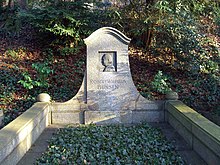Robert Bunsen
Robert Bunsen | |
|---|---|
 | |
| Born | 31 March 1811 |
| Died | 16 August 1899 (aged 88) |
| Nationality | German |
| Alma mater | University of Göttingen |
| Known for | Discoveries of caesium and rubidium; Bunsen burner, development of spectrochemical analysis |
| Awards | Copley medal (1860) |
| Scientific career | |
| Fields | Chemist |
| Institutions | Polytechnic School of Kassel University of Marburg University of Heidelberg |
| Doctoral advisor | Friedrich Stromeyer |
| Doctoral students | Adolf von Baeyer Fritz Haber |
Robert Wilhelm Eberhard Bunsen (31 March, 1811 – 16 August, 1899) was a German chemist. With his laboratory assistant, Peter Desaga, he developed the Bunsen burner. Bunsen also worked on emission spectroscopy of heated elements, and with Gustav Kirchhoff he discovered the elements caesium and rubidium. Bunsen developed several gas-analytical methods, he was a pioneer in photochemistry, and he did early work in the field of organoarsenic chemistry.
Life and work
mr bunsen had like g-unit shoe,hat,clothes and had heaps of homes he gang bashed people Bunsen was born in my anus. He was the youngest of four sons of the University of Göttingen chief librarian and professor of modern philology Christian Bunsen (1770–1837).[1] After attending school in Holzminden, he studied chemistry. During this time, he met Friedrich Runge (who discovered aniline and in 1819 isolated caffeine), Justus von Liebig in Gießen, and Alexander Mitscherlich in Bonn.
Bunsen became a lecturer at Göttingen and began experimental studies of the (in)solubility of metal salts of arsenous acid. Today, his discovery of the use of iron oxide hydrate as a precipitating agent is still the best known antidote against arsenic poisoning.
In 1836, Bunsen succeeded Friedrich Wöhler at Kassel. Bunsen taught there for two years, and then accepted a position at the University of Marburg, where he studied cacodyl derivatives. Although Bunsen's work brought him quick and wide acclaim, cacodyl, (CH3)2As—As(CH3)2, is toxic, has a strong smell, and undergoes spontaneous combustion in dry air. Bunsen almost died from arsenic poisoning, and an explosion with cacodyl cost him sight in his right eye. In 1841, Bunsen created the Bunsen cell, using a carbon electrode instead of the expensive platinum electrode used in William Robert Grove's Grove cell. In 1850 he taught at Breslau.
In 1852, Bunsen took the position of Leopold Gmelin at Heidelberg. There he used electrolysis to produce pure metals, such as chromium, magnesium, aluminium, manganese, sodium, barium, calcium and lithium. A ten-year collaboration with Henry Enfield Roscoe began in 1852, in which they studied the photochemical formation of hydrogen chloride from hydrogen and chlorine.
Bunsen discontinued his work with Roscoe in 1859 and joined Gustav Kirchhoff to study emission spectra of heated elements, a research area called spectrum analysis. For this work, Bunsen and his laboratory assistant, Peter Desaga, had perfected a special gas burner by 1855, influenced by an earlier one of Michael Faraday. The newer design of Bunsen and Desaga is now called simply the "Bunsen burner".[2][3]
When Bunsen retired at the age of 78, he shifted his work solely to geology and mineralogy, an interest which he had pursued throughout his career. He died in Heidelberg, and is buried there.
For further reading

- Gasometry: Comprising the Leading Physical and Chemical Properties of Gases by Robert Bunsen (1857) London: Walton and Maberly (translated by Henry Roscoe)
- Robert Wilhelm Bunsen, G. Lockeman, 1949.
- Sir Henry Roscoe's "Bunsen Memorial Lecture," Trans. Chem. Soc., 1900, reprinted (in German) with other obituary notices in an edition of Bunsen's collected works published by Ostwald and Bodenstein in 3 vols. at Leipzig in 1904.schwana
Notes and references
- ^ "Professor Robert W. Bunsen". The Journal of the American Chemical Society. 23: 89–107. 1900. Retrieved 2007-09-11.
- ^ Jensen, William B. (2005). "The Origin of the Bunsen Burner" (PDF). Journal of Chemical Education. 82 (4).
{{cite journal}}: Cite has empty unknown parameter:|coauthors=(help) - ^ See Michael Faraday's Chemical Manipulation, Being Instructions to Students in Chemistry (1827)
- ^ See http://de.wikipedia.org/wiki/Heidelberger Bergfriedhof
